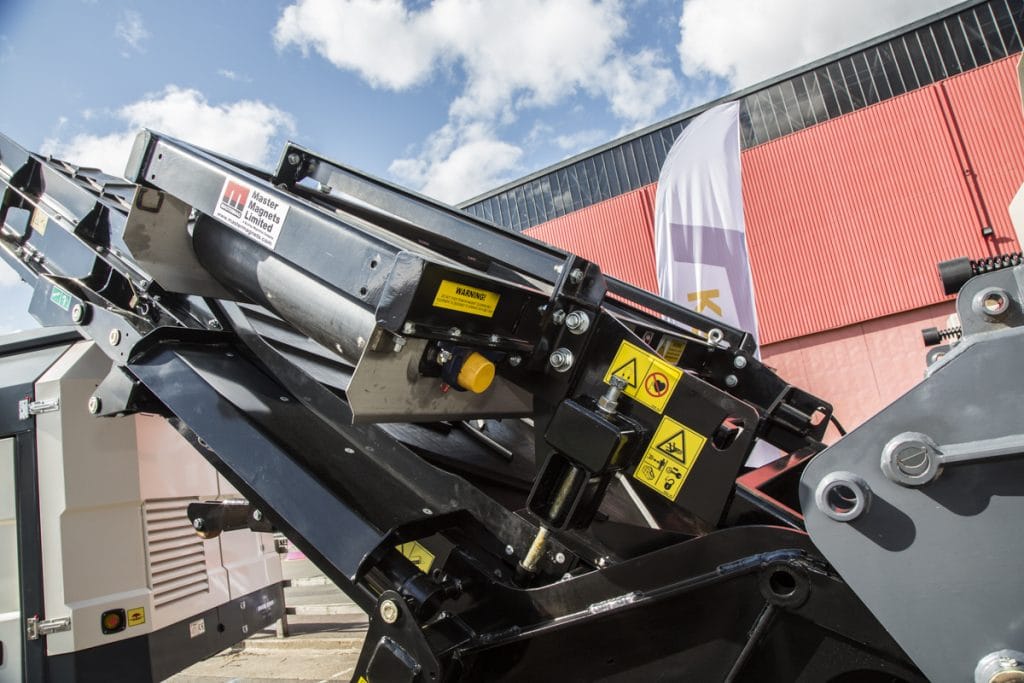Ferrite or Rare Earth Overband Magnet?
By Paul Fears | 13 June 2018
The Permanent Overband Magnet is one of the most commonly used Magnetic Separators. It is a simple system with a permanent magnet block positioned between two pulleys around which rotates a self-cleaning belt. The Overband Magnet is positioned above a conveyor transporting material and when ferrous metal enters the magnetic field it is lifted and removed. Overband Magnets can be found in quarries, mines, recycling plants, and even food factories.
Traditional Overband Magnets are made using ferrite magnets. The assembly involves placing blocks or slabs of ferrite magnet inside a stainless-steel casing, which is then ‘charged’ making the assembly magnetic.
In recent years, companies needing Overband Magnets have often been presented with two options:
- The traditional Ferrite Overband Magnet;
- The newer Rare Earth Overband Magnet;
What is a Rare Earth Overband Magnet?
The Rare Earth Overband Magnet uses high strength Neodymium Iron Boron (Rare Earth) Magnet blocks instead of lower strength Ferrite. The magnetic block is assembled ‘live’ (ie with the magnets already charged and magnetic).
Rare Earth Overband Magnets originally evolved to meet the growing desire for lower weight and stronger Overband Magnets, especially on mobile plant such as crushers and screens. However, the Rare Earth Overband Magnet has certain limitations when compared with the traditional Ferrite cousin.

Potential Problems with the Rare Earth Overband Magnet
The phrase ‘stronger is not always better’ has never been more appropriately applicable than with the Overband Magnet. In operation, the Rare Earth Overband Magnet has several important disadvantages including:
- A shallow magnetic field: This means that the magnetic field is only projected a short distance away from the bottom of the magnetic block and down into the conveyed material. Therefore, the Rare Earth Overband Magnet has to be positioned closer to the surface of the conveyed material. This is not always possible and is also not suitable when there are surges of material;
- A very strong magnetic hold on the surface: The magnetic power of the Rare Earth Overband Magnet on the surface of the magnetic block is substantial. However, this can be problematic if larger tramp metal is being separated as the magnetic attraction will be so strong that the captured metal will not be able to be automatically removed by the self-cleaning belt. This results in belt, bearing and motor damage. Additionally, the removal of large metal stuck to the bottom of the Rare Earth Overband Magnet can be a serious health and safety issue and the removal can be very dangerous;
So Which Overband Magnet?
There are many ideal applications for the Rare Earth Overband Magnet. If the burden depth of the conveyed material is constant and small, then the Rare Earth Overband can be positioned close and will enable a good separation of smaller tramp metal.
Equally, if the metal contamination in the conveyed material is small, then the Rare Earth Overband Magnet has an improved chance of separation. However, other designs of Magnetic Separator, such as a Pulley Magnet or Drum Magnet, might be more suitable.
As a general rule, if the tramp metal is large (e.g. ReBar, beverage cans, larger bolts, rods, etc), then the most suitable Overband Magnet is the traditional Ferrite version.
When we receive an enquiry for any Magnetic Separator, our applications team review the information before recommended the most suitable solution. For more information or prices for Overband Magnets, please contact us on:
Email: sales.redditch@buntingmagnetics.com
Telephone: +44 (0) 1527 65858



